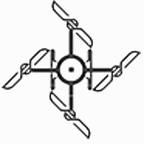Long-duration autonomy for small rotorcraft UAS including recharging
Reliable Unmanned Aerial Vehicle (UAV) that are capable of performing long-duration missions autonomously received a lot of attention during the past years. Numerous applications such as the delivery of packages, surveillance and the acquisition of scientific data over a longer period of time are of particular interest to the industry.
Christian Brommer (AAU), Danylo Malyuta(UW), Daniel Hentzen(JPL) and Roland Brockers(JPL) conducted profound research and engineering to develop a high-level autonomy framework that is capable of performing autonomous long-duration missions without humans in the loop.
The Paper “Long-Duration Autonomy for Small Rotorcraft UAS including Recharging” is the result of a joint publication of NASA’s Jet Propulsion Laboratory (JPL) and the Control of Networked Systems group (CNS) lead by professor Stephan Weiss at the Universität Klagenfurt (AAU). The article presents the impressive results and lessons learned during JPL’s long-duration autonomy project first led by Stephan Weiss and then by Roland Brockers. A complete solution for a long duration system that performs missions completely autonomous and without human interaction was not available at the time the article was published. Existing research allowed indoor flight times of 24 hours by utilizing motion capturing systems. The system that is presented in the paper extends the scope of indoor flights and performed outdoor experiments with flight times of over 11 hours of fully autonomous operation. These results are archived by deploying robust state-estimation with multiple sensors such as GPS position and velocity, magnetometer, barometer and IMU. A robust autonomy engine ensures the correct generation of a waypoint based mission profile and its reliable execution. A cascaded three-stage control architecture for translation, attitude and body rate ensures the accurate trajectory following with improved disturbance rejection due to a fast inner loop control. The system performs pre-flight checks before each take-off, monitors the health of the system and executes emergency response profiles if the battery level is insufficient and the vehicle can not reach the landing zone.
A vision based precision landing approach together with a bundle of visual markers overcomes the remaining uncertainty of the position estimate caused by the limited accuracy of the GPS system. The system used a contact based charging pad for the recharging of the vehicle. This contact based charging allows fast recharging that leads to a high number of repeated autonomous mission executions. The system was extensively tested during experiments that included a FLIR thermal camera for scientific data acquisition.
The presented system paper describes the individual components that lead to impressive 11 hours of indoor flights with 48 mission executions and 4 hours of outdoor flight with 24 mission executions and no human interaction after the initialization of the system.
Publication
[1] Christian Brommer, Danylo Malyuta, Daniel R. Hentzen, and Roland Brockers. Long-duration autonomy for small rotorcraft UAS including recharging. In Proc. IEEE/RSJ International Conference on Intelligent Robots and Systems (IROS), 2018.
@inproceedings{Brommer2018,
title = {Long-Duration Autonomy for Small Rotorcraft {UAS} Including Recharging},
author = {Christian Brommer and Danylo Malyuta and Daniel Hentzen and Roland Brockers},
year = 2018,
month = oct,
booktitle = {2018 {IEEE}/{RSJ} International Conference on Intelligent Robots and Systems ({IROS})},
publisher = {{IEEE}},
pages = {7252-7258},
doi = {10.1109/IROS.2018.8594111},
issn = {2153-0866}
}Originally published at https://medium.com on June 11, 2019.
